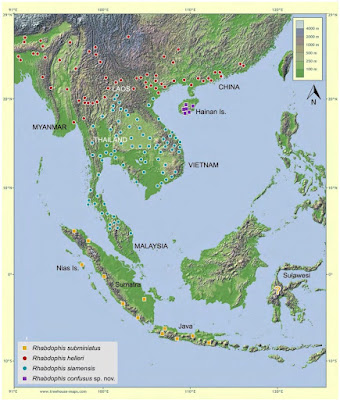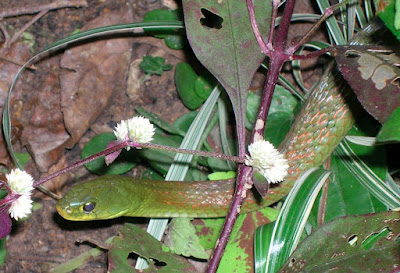 |
| Rhabdophis confusus David & Vogel, 2021; R. helleri (Schmidt, 1925); Rhabdophis subminiatus (Schlegel, 1837); งูลายสาบคอแดง R. siamensis (Mell, 1931) in David & Vogel, 2021. TAPROBANICA. 10(2) |
Abstract
The systematics of Rhabdophis subminiatus (Schlegel, 1837) at subspecies level has long proved to be controversial. We analyse the variation of selected morphological characters in 179 specimens from populations covering the whole range of R. subminiatus sensu lato. Based on this review, we recognize four morphological groups, of which two do not agree with the current definitions and distributions of the currently recognized subspecies R. s. subminiatus. The ―northernmost group‖ agrees with the definition of Natrix helleri Schmidt, 1925. In contrast, the ―southernmost group‖ agrees with the syntypes of Tropidonotus subminiatus and we here restrict this species to the Sunda Region. We also discuss a previous designation of the lectotype of T. subminiatus, which we consider invalid, and we here make it valid in the sense of the Code. Furthermore, our analysis allows us to define a third group that is widespread in the Indochinese Region and Malayan Peninsula. For this geographically ―central group‖, the name Natrix subminiata siamensis Mell, 1931, is available. We therefore resurrect this taxon from its synonymy with R. subminiatus and we designate a lectotype in agreement with requirements of the Code. Lastly, we recognize a fourth group at species level, endemic to Hainan Island, China, that we describe as a new species. This division into four morphological groups at species level is coherent with phylogenetic analyses recently published in the literature. We also discuss and modify the taxonomic status of Natrix subminiata hongkongensis Mell, 1931 and Natrix (Rhabdophis) laobaoensis Bourret, 1934, now regarded as synonyms of R. subminiatus and R. siamensis, respectively.
Key words: Asia, Hainan, lectotype, morphological variation, Natricidae, Natrix, Serpentes, taxonomy
 |
| Distribution map of the species Rhabdophis subminiatus (yellow squares), R. helleri (red circles), R. siamensis (blue circles), and Rhabdophis confusus sp. nov. (purple squares). |
Diagnosis. A medium-sized species of the genus Rhabdophis characterized by the combination of (1) 19 (rarely 17 or 21) – 19 – 17 dorsal scale rows; (2) dorsal scales narrowly but strongly keeled, scales of 1 st DSR smooth; (3) nuchal groove not visible (exceptionally a shallow groove barely visible); (4) no enlarged (exceptionally slightly enlarged) nuchal scales; (5) VEN: 132–145; SC: 59–78, paired, (6) dorsum in various shades of olive-brown, greyish-brown or pale brown, distinctly chequered and spotted with dark grey or black, diffuse blotches; (7) a pale, i.e., cream or pale yellowish-brown, dorsolateral stripe most usually present on 5th –6 th dorsal scale rows, either complete or reduced to a series of longitudinally aligned pale rectangular blotches; (8) nape very dark grey or black in juvenile specimens, dark green or brown in adults; (9) upper surface and sides of the neck and anterior part of the body extensively tinged with bright vermilion-red or coral; (10) a dark brown or black subocular streak usually present (exceptionally totally absent); (11) subocular streak shaped as a narrow vertical bar or as narrow streak curved downwards or even forwards (Fig. 2A–F), resembling a comma on left side of the head), rarely a broad vertical bar or as a thick streak initially directed backwards then curved downwards; (12) venter always pale, i.e., cream or creamish-yellow, with a dark dot on the tips of each ventral, rarely only on the anterior part of the venter. The comparisons between Rhabdophis subminiatus and the three other species treated here are given in the respective accounts of these species.
Distribution. (Fig. 9) Indonesia: Java: throughout the island. Sumatra: Aceh, North Sumatra, West Sumatra, Bengkulu, and South Sumatra; probably throughout the island (David & Vogel 1996). Nias Island. No specified locality. Sulawesi: North (?).
Rhabdophis helleri (Schmidt, 1925)
Natrix helleri Schmidt, 1925: 3
Diagnosis. A large-sized species of the genus Rhabdophis characterized by the combination of (1) 19 (rarely 17, 18, 20 or 21) – 19 – 17(rarely 15) dorsal scale rows; (2) dorsal scales narrowly but strongly keeled, scales of 1st DSR smooth; (3) strong nuchal groove, well visible; (4) 2–8 distinctly enlarged, aligned nuchal scales; (5) VEN 157–178, SC 75–97, paired; (6) dorsum usually olive-green or dark greyish-green, or dark grey or brown, usually nearly uniform or chequered with black; (7) red hue on the neck present and usually conspicuous, although sometimes subdued; (8) dark subocular streak often totally absent or reduced to a few dots, or incomplete, or, more rarely, conspicuous; (9) when present, subocular streak shaped as a vertical bar or an incomplete triangle directed backwards, more or less faint and faded in its middle, rarely solid black and conspicuous, or as a broad comma; (10) venter cream or creamish-yellow anteriorly becoming on a short distance heavily dotted with dark grey backward.
Rhabdophis siamensis (Mell, 1931) comb. nov.
Natrix subminiata siamensis Mell, 1931: 203
Natrix (Rhabdophis) laobaoensis Bourret, 1934: 169 (p. 5 of the separate)
Diagnosis. A moderately-sized species of the genus Rhabdophis characterized by the combination of (1) 19(rarely 17, 18 or 21) – 19 – 17(rarely 16 or 18) dorsal scale rows; (2) dorsal scales narrowly but strongly keeled, scales of 1st DSR smooth; (3) nuchal groove always present, moderate to strong; (4) 3–8 enlarged, paired nuchal scales; (5) VEN 137–156, SC 65–89, paired; (6) dorsum yellowish-grey, greyishbrown or pale brown, distinctly spotted with black and cream blotches; (7) upper surface and sides of the neck bright vermilion-red, sometimes subdued in larger specimens or in long-preserved specimens; (8) a dark brown or black subocular streak always present; (9) dark subocular streak shaped as a broad triangular streak (rarely faint), directed backwards; (10) venter pale, i.e., cream or creamish-yellow, without dark dots on the tips of ventrals, or only on the anterior part of the venter.
Rhabdophis confusus sp. nov.
Diagnosis. A medium-sized species of the genus Rhabdophis endemic to Hainan Island, characterized by the combination of (1) 19 – 19 – 17dorsal scale rows; (2) dorsal scales narrowly but strongly keeled, scales of 1st DSR smooth; (3) a moderate nuchal groove present, well visible; (4) 4–8 distinctly enlarged, aligned paired nuchal scales; (5) VEN 144–158, SC 56– 79 paired; (6) dorsum olive-green or dark greyish-green, dark greyish-brown or dark reddish-brown, distinctly chequered with diffuse, black blotches; (7) red hue on the upper part and sides of the neck faint or absent; (8) dark subocular streak totally absent; (10) venter uniform cream or pale creamish-yellow, without dark dots on the tips of ventrals but with outer fifth or quarter of ventrals heavily mottled with dark grey.
Etymology. The specific nomen is the Latin adjective confusus (-a, -um), here in masculine gender, meaning ―confused‖ or ―mixed, based on the confusion of this species with Rhabdophis siamensis.
We suggest the following common names: Hainan Island keelback snake (English), Rhabdophide de Hainan (French), Hainan Rothals-Wassernatter (German), and 拟红脖颈槽蛇, Nǐ Hóng Bó Jǐng Cáo Shé (Chinese).
Patrick David and Gernot Vogel. 2021. Taxonomic Composition of the Rhabdophis subminiatus (Schlegel, 1837) Species Complex (Reptilia: Natricidae) with the Description of A New Species from China. TAPROBANICA. 10(2); 89–120.





